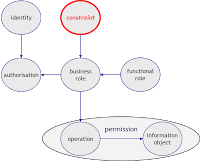Not, many of you may have read this Blog post before here, posted at Sat. June 30th to the GenericIAM Blog. Here I made the statement that "Roles are the organization". You may read through this short contribution before you go on listening to me.
And please always feel free to come up with a different opinion or with some critique as did one BLOG author - who unfortunately did not completely get the point.
Well, maybe I overstated my point there. More will be necessary to describe how an organization is expressed in roles.
And please always feel free to come up with a different opinion or with some critique as did one BLOG author - who unfortunately did not completely get the point.
Well, maybe I overstated my point there. More will be necessary to describe how an organization is expressed in roles.
What are roles?
When we talk about roles they are most commonly understood as functional roles. That means bundled corporate functions. So if you have a functional enterprise model (as opposed to an object oriented one) at hand, you may just select the appropriate functions, add them the functional role and give it a meaningful name. Yes, that's all.
Will it be enough to use these roles for granting access? Remember this is the idea behind Role Based Access Control (RBAC) after all. No, it will not.
But how do we get there? Ok, let's take a step back and consider the organization and all the objects around there and see what we can collect to finally have all determining information at had to define privileges.
Will it be enough to use these roles for granting access? Remember this is the idea behind Role Based Access Control (RBAC) after all. No, it will not.
But how do we get there? Ok, let's take a step back and consider the organization and all the objects around there and see what we can collect to finally have all determining information at had to define privileges.
What is the organization?
 |
| Figure 1: Roles link process to resources |
Processes - Roles - Rules - they express the abstract Organization. They form a generic template not yet populated with real people and still without individual customers, contracts and obligations. So we are on the class level still - not yet their physical incarnation. As mentioned - it's the abstract organization.
So let's follow a top-down modelling approach:
So let's follow a top-down modelling approach:
- Business processes express the organization's dynamic behavior. Often they are the starting point. They are best understood and perceived as been the essence of the corporation - something to excel or to fail in.
- Processes themselves are made up of elementary actions which can be understood as some atomic activity - what one person does at a time in one location.
- These actions are performed by someone - not yet individual persons but on class level roles instead. So here they come into play - the roles, functional roles still.
- To be able to perform the singular actions these functional roles need appropriate access to resources. The functions are bound to resources. They are being "localized".
- Constraints drive this localization. They further restrict the roles access to certain subclasses in order to reflect the real world's needs. Those constraints express the privilege determining information dimensions like organizational unit, region, contract type, customer group and more. The resulting "business role" finally is the one which can be used for access control as it defines the intended privileges - still defined in business terms.
So processes and roles can't be modeled independently - without being incomplete. But only by taking constraints into account makes the model sufficiently determined to derive privileges for information object access from functional roles.
This picture to my opinion is more straight forward and easier to comprehend than the so called Stanford model:
This picture to my opinion is more straight forward and easier to comprehend than the so called Stanford model:
Obviously role finding requires good and - even more important - explicitly documented knowledge of the business domain (best to be expressed in a formal enterprise model), some experience in related business modelling areas and a sound portion of intuition.
While existing, defined and documented business processes are an excellent starting point for successful role engineering, they still don't represent the most fundamental core objects of a corporation. Even more fundamental to an organization are the essential persistent (non-transient) objects:
While existing, defined and documented business processes are an excellent starting point for successful role engineering, they still don't represent the most fundamental core objects of a corporation. Even more fundamental to an organization are the essential persistent (non-transient) objects:
 |
| The static IAM objects |
The static IAM-Objects
Anchor point is the business role - ok, but let's start at the beginning - always a good idea. In this chapter I might reiterate ideas of earlier postings. However - as insight has progressed - my explanations may get a slightly different flavor than before. In case you feel bored just skip this chapter. But be warned - as virginal ideas are rare in general - you might encounter the usual suspects.
Processes of model maintenance
Those were the fundamental objects (again). But how to get the strange animals called roles now? Well, if you are asking for processes I finally have to deliver processes. Let's not forget: this is what GenericIAM is about, generic processes of the identity & access management.
So which processes do we need at first? Model maintenance means the maintenance of all of its objects. So we obviously may expect …
- Maintain functional role,
- Maintain constraint,
- Maintain permission and
- Maintain business role.
Maintain functional role:
Due to the high overlap with job descriptions, the functional roles can be considered as the natural starting point for a role based privilege assignment.If requirements for separations of duties (SoD) are defined, functional roles are the appropriate object to check for violations as separations of duties are defined purely functionally as well. If the SoD conflicts cannot be resolved otherwise the implementation of mitigating actions (aka compensating controls) might become necessary. This SoD check becomes necessary when functional roles are either edited or combined.
The process of functional role maintenance is triggered by the initial creation of new tasks or change of existing ones, e.g. caused by changes of business processes. In these cases creations or changes of functional roles might become necessary.
Owner of this process should be some kind of business architect. To model functional roles he clarifies, which tasks within a business process are planned. By following along its elementary activities (what a person does at in one step at one location) he lists the functions according to the enterprise model that are necessary to run this activity.
If SoD obligations have to be met the resulting functional roles have to be checked for segregation of duties conflicts. If present such conflicts can be either removed by remodeling or their inherent risk be reduced by implementation of compensating controls.
Maintain constraint:
Constraints are used to further restrict the functions acquired via the assignment of a functional role. The definition of constraints is a risk mitigating measure, which can be implemented additionally or alternatively to other controls (four eyes principle, separation of duties …) to function as a "compensating control".The process can be invoked by "maintain functional roles" as it narrows their focus. It should be owned by the above before mentioned business architect too.
The necessity for the definition of constraints is originated by business departments, risk management or - if appointed - a business architect. Together they determine the scope limitation or the maximum authorization level.
Maintain business role
As mentioned above in this model the business role is the central element of access management. By assigning a business role to a person's digital identity they are granted their privileges. This assignment is stored in the authorization object. The business role is therefore the static projection of the functional role to certain information objects while applying some constraints.In a 1st step a functional role is created as an empty container. It is given a meaningful name expressing the purpose of this role. Alternatively an existing functional role is selected from the enterprises pool of functional roles.
In a 2nd step corporate functions taken from a functional enterprise model are assigned to the functional roles. Note: in order to comply with the principle of least privilege (PoLP) only a minimum set of corporate functions should be selected in this step. Obviously for this purpose the functional enterprise model needs to be sufficiently fine grained. If necessary at this stage you may want to change functional roles or create new ones (maintain functional role).
In a 3rd step the constraints are applied to the business roles. This action obviously increases their number. A check for violations of segregation of duties requirements may be appropriate here as well.
In a 4th step permissions are assigned to the business roles. Obviously here the respective Information owners need to get involved. Remember: Permissions are defined as operations on information objects. In cases where no information objects are defined but systems or applications in place instead you may need to consider permissions as 'operations on applications'. If necessary those permissions need to be changed or created (using the process "maintain permission").
The business role can still be understood on the business level. Not surprisingly we suggest the business architect again to be the appropriate owner. He will not be able to do this job alone. He might need the support of the information object owner / application or system architect.
Maintain permission:
What's about the permission? Doesn't it need to be maintained as well? Yes it does. However most often this is done in a different system: In the target systems rather than in a central AM system. While modeling these processes on the essential level however we need not to deal with these system boundaries.Of course to decide which ones of the possible permissions to be exposed to the business oriented role modelers is a business decision. On the other hand only those permissions can be exposed, which are offered by the underlying systems. Clearly this is the domain of the information object owner / application or system architect.
Moreover in those cases where the underlying systems offer their own role models and especially in situations when roles on system level are in use by an implemented access management already application- or system roles can be squeezed in between the permission on the bottom level and the business role
in the center. As in the essential model there is no reason for the introduction of an application role, some extra discussion will be required in order to find a set of rules for crafting good application roles - but elsewhere.














